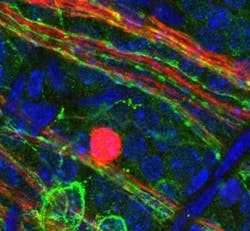Violet light therapy could help premature infants avoid vision problems
Researchers at Cincinnati Children's Hospital Medical Center (Cincinnati, OH) have discovered a light-dependent molecular pathway that regulates how blood vessels develop in the eye. The findings suggest it may be possible to use light therapy to help premature infants whose eyes are still developing avoid vision problems.
Called the opsin 5-dopamine pathway, the novel molecular process helps ensure blood-vessel development in the eye is appropriately balanced to prepare it for visual function. The process can be thrown out of balance in medically fragile premature babies. Researchers are looking for ways to prevent or treat the eye diseases retinopathy of prematurity and myopia (severe nearsightedness) that can result.
"Our study indicates opsin 5-dopamine pathway is probably part of a light-dependent disease process for conditions like myopia, which is now a worldwide epidemic," says Richard A. Lang, Ph.D., director of the Visual Systems Group at Cincinnati Children's and senior author of the paper that describes the work. "It raises the interesting possibility that we might be able to use light exposure to treat conditions like retinopathy of prematurity after a premature infant is born or in people with myopia."
The study is a collaboration of research institutions in the U.S. and Czech Republic, led by Lang's team in Cincinnati. The researchers used a variety of scientific methods to study eye development and the influences of the opsin 5-dopamine pathway in postnatal mice. Lang said opsin 5 is highly conserved in the chain of species evolution, enhancing the data's potential relevance to humans.
During postnatal eye development in mice, an embryonic network of hyaloid blood vessels regresses in a process that requires precise timing in order for the mice to develop high-acuity vision.
The researchers demonstrate in their mouse models that the developing postnatal eye depends on light responses in the retina that are controlled by opsin 5, a protein that is expressed in special photoreceptor cells in the retina. Opsin 5 and the neurotransmitter dopamine—which promotes blood vessel regression—work in unison to regulate the eye's balanced vascular development.
This microscopic image shows light-sensitive opsin proteins in the retinal ganglia nerve fibers of the neonatal mouse eye, helping scientists identify the role and importance of opsin proteins (like OPN4 and OPN5) in the developing neonatal eye. Researchers are looking for light-based therapies that might prevent or treat eye diseases like retinopathy of prematurity in premature babies or the condition myopia. (Image credit: Cincinnati Children's)
To show what would happen without the balancing influence of opsin 5, researchers studied genetically modified mice that do not express the OPN5 in the retina. Loss of opsin 5 increased levels of dopamine in the vitreous—the clear, gel-like substance in the eye. This caused hyaloid blood vessels in the still-developing eyes to regress very quickly, hindering normal eye development.
To test the influence of light stimulation, the researchers used 380 nm violet light to activate signaling via opsin 5. This reduced dopamine levels in the eye and produced other molecular changes that helped restore proper timing cues needed for appropriately balanced vascular development.
Previous studies have suggested that violet light and dopamine may be key regulators of eye development. And although findings in the current study require additional research to become clinically relevant to humans, the data do demonstrate that balanced coordination in the opsin 5-dopamine pathway is important to healthy eye development in baby mice, and possibly in human babies.
Full details of the work appear in the journal Nature Cell Biology.
